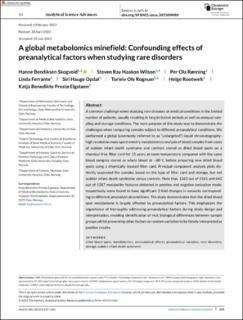| dc.contributor.author | Skogvold, Hanne Bendiksen | |
| dc.contributor.author | Wilson, Steven Ray Haakon | |
| dc.contributor.author | Rønning, Per Ola | |
| dc.contributor.author | Ferrante, Linda | |
| dc.contributor.author | Opdal, Siri Hauge | |
| dc.contributor.author | Rognum, Torleiv Ole | |
| dc.contributor.author | Rootwelt, Helge | |
| dc.contributor.author | Elgstøen, Katja B. Prestø | |
| dc.date.accessioned | 2023-11-23T06:57:54Z | |
| dc.date.available | 2023-11-23T06:57:54Z | |
| dc.date.created | 2023-09-19T16:43:29Z | |
| dc.date.issued | 2023 | |
| dc.identifier.citation | Analytical Science Advances (ASA). 2023, 4 (7-8), 255-266. | en_US |
| dc.identifier.issn | 2628-5452 | |
| dc.identifier.uri | https://hdl.handle.net/11250/3104204 | |
| dc.description.abstract | A common challenge when studying rare diseases or medical conditions is the limited
number of patients, usually resulting in long inclusion periods as well as unequal sam-
pling and storage conditions. The main purpose of this study was to demonstrate the
challenges when comparing samples subject to different preanalytical conditions. We
performed a global (commonly referred to as “untargeted”) liquid chromatography-
high resolution mass spectrometry metabolomics analysis of blood samples from cases
of sudden infant death syndrome and controls stored as dried blood spots on a
chemical-free filter card for 15 years at room temperature compared with the same
blood samples stored as whole blood at −80◦C before preparing new dried blood
spots using a chemically treated filter card. Principal component analysis plots dis-
tinctly separated the samples based on the type of filter card and storage, but not
sudden infant death syndrome versus controls. Note that, 1263 out of 5161 and 642
out of 1587 metabolite features detected in positive and negative ionization mode,
respectively, were found to have significant 2-fold changes in amounts correspond-
ing to different preanalytical conditions. The study demonstrates that the dried blood
spot metabolome is largely affected by preanalytical factors. This emphasizes the
importance of thoroughly addressing preanalytical factors during study design and
interpretation, enabling identification of real, biological differences between sample
groups whilst preventing other factors or random variation to be falsely interpreted as
positive results. | en_US |
| dc.language.iso | eng | en_US |
| dc.rights | Navngivelse 4.0 Internasjonal | * |
| dc.rights | Navngivelse 4.0 Internasjonal | * |
| dc.rights.uri | http://creativecommons.org/licenses/by/4.0/deed.no | * |
| dc.title | A global metabolomics minefield: Confounding effects of preanalytical factors when studying rare disorders | en_US |
| dc.type | Peer reviewed | en_US |
| dc.type | Journal article | en_US |
| dc.description.version | publishedVersion | en_US |
| cristin.ispublished | true | |
| cristin.fulltext | original | |
| cristin.qualitycode | 1 | |
| dc.identifier.doi | 10.1002/ansa.202300010 | |
| dc.identifier.cristin | 2176701 | |
| dc.source.journal | Analytical Science Advances (ASA) | en_US |
| dc.source.volume | 4 | en_US |
| dc.source.issue | 7-8 | en_US |
| dc.source.pagenumber | 255-266 | en_US |

